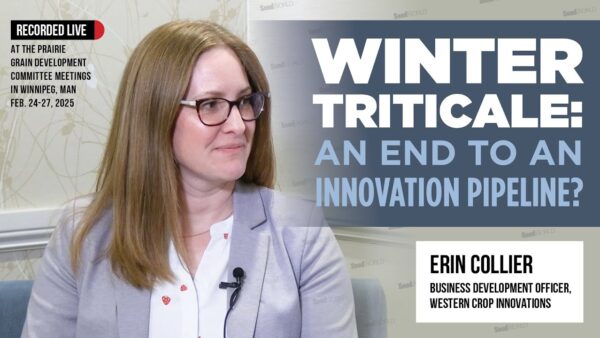
Seeds Under Attack
Germination puts rumours about the seed industry to rest.
Canada’s seed industry provides employment for more than 14,000 people and contributes approximately $5.6 billion to the Canadian economy, according to the Canadian Seed Trade Association.
And like a lot of other massive industries, the seed industry is the source of a lot of speculation — and myth. There are myths about the industry’s supposed monolithic make up, its bias toward biotech firms and its dominance by multinational corporations. There’s also the belief that some of the industry’s largest corporations take advantage of farmers.
But then there are the realities.
To be sure, many of these myths are slowly eroding, says Patty Townsend, CEO for CSTA. “The perceptions of the seed industry are changing,” she says. “Four or five years ago you would have heard that the seed trade is dominated by multinationals that don’t want to invest in Canada. But the seed trade has evolved.
“Yes, there are big multinationals we all know about, but there’s also a large portion of that trade made up of smaller businesses or those working as part of collaborations or cooperatives. The industry has been evolving,” she says.
Townsend adds that there are “hundreds and hundreds” of industry participants that have no biotech connection whatsoever. “The seed industry is much more diverse than people think it is and than people portray it,” she says.
Townsend credits some of the seed industry’s evolving perceptions to increased transparency and a more open atmosphere and because more people better understand it.
Myths Exist
Still, some of the myths persist. Here are a few:
1. Large seed corporations take advantage of farmers. There’s a perception that many farmers are unsophisticated and ill-informed about the contracts they sign with big companies to use their patented products. As a result, the perception goes, they often end up in legal hot water with these companies.
“But farmers are very well versed in the contractual arrangement about seeds,” says Trish Jordan, public and industry affairs director of Monsanto Canada in Winnipeg.
“I think that’s a general misunderstanding.
“If you asked most farmers if they would rather have the technology and not have to sign a contract, I think most would say yes. But farmers are sophisticated. They realize that to have access to new seed and enhanced seed, these things cost money, and when there are benefits, they are more than willing to sign these agreements,” Jordan says.
Monsanto, in particular, arouses the ire of activists for perceived hardball tactics. One common misconception is that if a Monsanto seed accidentally lands in a farmer’s field, the company will go after the farmer in court, says Jordan.
“We have never done that and we will never do that,” she says. “It’s something that comes up in activist circles, that if our seed comes in by wind or a bird drops it there, then Monsanto will sue. We’re never going to do that.”
2. New seed technology disproportionately benefits big companies that produce them. There’s no question everyone in this business — farmers, retailers, biotech firms, small and big seed companies — are in this to make money. But even for the large corporations, the profits are not as wide as some believe.
“For the farmers using enhanced seed varieties, there’s some question about how much of the benefit comes to me and how much goes to you or the shareholders,” says Jordan. “When new seed comes out the grower generally sees that the seed cost goes up.
“Where it gets tricky is when they’re paying a lot of investment for the seed up-front in the hope that everything turns out perfect. For farmers there may sometimes be a question about whether they’re getting fair share of the value. Our commitment is to share fairly in value. If the product generates a dollar of value, we trying to split that three ways. We don’t sell directly to the farmer and so we try to share value with the retail network. And the balance obviously goes to the farmer.”
Stephen Denys, vice-president of sales and marketing for Pride Seeds and a farmer who grows corn, soybeans, winter wheat and white beans in Chatham, Ont., says understanding the perspective of the seed company is important.
“The reality is the seed company has an investment,” Denys says. “One of the causes of the misunderstanding is the belief that the investment is only in that seed.
“That investment has to be recouped. You have to get some return in order to stay in business. And you’re not going to stay in business if you’re not giving the farmer something good or better than he had before,” he says
3. The industry is a made up of a few multinationals. Actually, the industry is very diverse, says Denys, a former CSTA president. “There are family-owned businesses and smaller businesses,” he says. “The board of directors for CSTA is made up of those producing organic seed products to those producing seeds with traits.
“The board membership is quite a cross section — from small packets to main crops and soybeans. All members, regardless of size, are well represented,” Denys says.
Townsend says these days the seed trade and the seed sector in general are much more inclusive.
“There’s such pressure on margins and everything else,” she says. “The seed industry and sector are working much more closely together.
“When they work together they understand what each other’s needs are, what their goals are and what their challenges are. The grain growers work closely with the seed industry and the seed industry with the horticulture industry. As they work together they start building trust and understand they can’t do it alone,” Townsend says.
4. Multinationals control seed prices. If only it were that simple. In fact, the seed market has become extremely competitive in recent decades, says Denys.
“There’s a feeling that seed producers are getting fat on the price of seed,” he says. “But the reality is the opposite. We stay in the business because we’re still able to make a return and for our shareholders, this is our core business. But the reality is that our margins are less than they were 20 years ago.”
More intense competition, he says, has contributed to shrinking margins. “Large producers have more price leverage,” he says. “There are good choices out there. You’ve got companies out there fighting for a shrinking number of producers.”
5. Farmers have no options when it comes to seed treatment. “The perception is that last year farmers were forced to buy treated seed,” Denys says. “The fact is every seed company offered an option without seed treatment on it. The reality is farmers have very clear choices. Some in government feel that farmers do not have a choice. The reality is farmers do have a choice.”
6. A drop in commodity prices means a drop in seed prices. Actually, there is no direct correlation between the cost of the commodity and cost of the seed.
There’s less of a connection between seed prices and commodity prices than there used to be. When you go into hybrid production you have costs there. Salaries have gone up. Safety standards have gone up over time. There’s been a wholesale change over 20 years in terms of what goes into a bag of seed corn. It’s a very different industry that it was.
Lekan Oguntoyinbo












